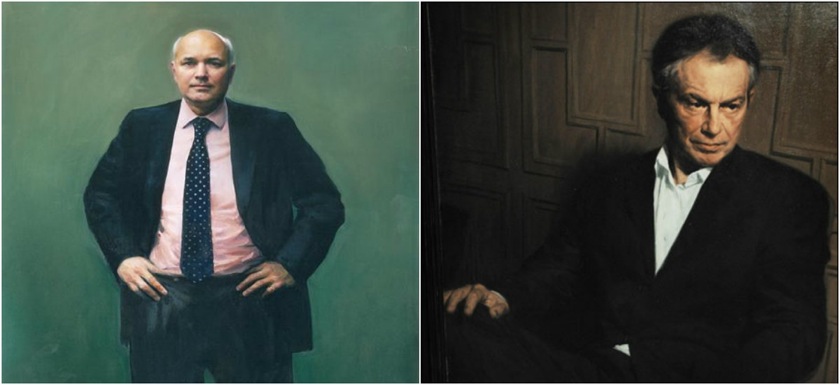An Evening Standard Freedom of Information request has revealed that £250,000 has been spent on portraits of parliamentarians since 1995. It is certainly a strong and provocative headline, but perhaps a little misleading in its attack on ‘expensive vanity portraits’. £250,000 sounds like a lot of taxpayer money, and certainly some of the more bombastic headlines have screamed that “YOU” have paid a quarter of a million pounds for paintings of people you probably don’t like. Of course, spread £250,000 over 19 years and it begins to look more reasonable. Divide that sum up by Britain’s approximately 30 million taxpayers and it becomes nearly insignificant. It may not make a very good headline, but the portraits have actually cost “YOU” a grand total of £0.0004 a year. At that rate, it won’t be until 2020 that you’ve paid a single penny.
If we remove the issue of the cost from the equation, we are left with the more interesting questions behind this story – why get these portraits done at all? And what do they tell us about the subjects?
Portraiture is an artistic genre that carries with it a set of potent associations. The history of portrait painting is one filled with depictions of great leaders who have left their mark on the world. Commissioned portraits (rather than those of an artist’s model) throughout history have captured kings and popes, military generals and secular leaders who shaped the landscape of their time. In return, through patronage, they allowed our greatest artists to practice their craft and produce their masterpieces. This relationship, in which great artists produce great paintings of great men, has led the statesman’s portrait to assume a status higher than may be immediately apparent. It is not just a painting that you receive when you sit; it is a position in a long and distinguished tradition.
With this in mind, the reason for the parliamentary portraits seems a little clearer. Politicians have rarely been reluctant to attempt to place themselves within a tradition of great rulers, after all. Consider also the fact that British politicians are often mocked and seldom liked. The vast majority of the time they see themselves artistically depicted is in satirical newspaper cartoons. The opportunity to sit for a flattering portrait after a long career of being drawn as a spineless weasel or horned demon is understandably attractive.
When you get past the outrage of their being commissioned, the portraits speak volumes about the subjects, and the manner in which they wish to be seen. The bronze statue of Margaret Thatcher that stands in the Members Lobby of the House of Commons depicts her apparently in mid-speech. The dynamism of the pose is in-keeping with the more positive aspects of her image, and she is shown with a pointing finger, extended as if to lead her MPs forward, even now. Diane Abbott is depicted head on, in close-up and seemingly nude – an uncompromising and open position from the left-wing backbencher. The implication is that she lays her principles bare and refuses to retreat from them – an interpretation supported by her history of rebelling against her own government on defence policy and tuition fees.
Thatcher and Abbott’s portraits try to accentuate certain qualities that they are known for, but in others, the opposite is the case. Michael Howard’s in particular seems to be an attempt at correcting the way in which he is usually seen. Howard, the former leader of the Conservative Party, has often been regarded as sinister and unsettling. Fellow Tory Ann Widdecome famously remarked there was ‘something of the night about him’. Perhaps with this in mind, his portrait features him smiling sweetly, casting a soft look out from the canvas.
The point of their career in which the subjects sat is also reflected in the paintings. Compare the portraits of Iain Duncan Smith and Tony Blair below. Iain Duncan Smith was painted in 2004, the year after he was replaced as leader of the Conservative Party after losing a vote of no confidence. He is shown bullish and defiant, with hands on hips as if to project resilience at a time that he was being labelled a spent force. Tony Blair, by contrast, is shown looking vulnerable and tired. The 2008 painting captures him having just stepped down from a premiership tainted by the wars in Iraq and Afghanistan. The portrait shows a statesman who was presented with tough decisions and feels keenly the pain and suffering of those affected by them. Incidentally, this is the view of himself that he attempted to put forward in his memoir two years later.
Unpacked then, the story takes on a different feel. This is not a scandal like that over MPs’ expenses (the cost in fact is just half of what Sinn Fein MPs claimed while refusing to turn up to Westminster), but something quite different. For £0.0004 a year, the taxpayer has purchased a better understanding of some of the most prominent figures of contemporary British politics. The result, far from being the ‘vanity portraits’ of the screaming headlines, is actually quite sad – a series of anxious eyes towards future history, pleading that they will not be remembered as an irrelevance or a joke, a sinister figure or a callous warmonger, but as something more. How successful they will be in this, of course, only time will tell.


